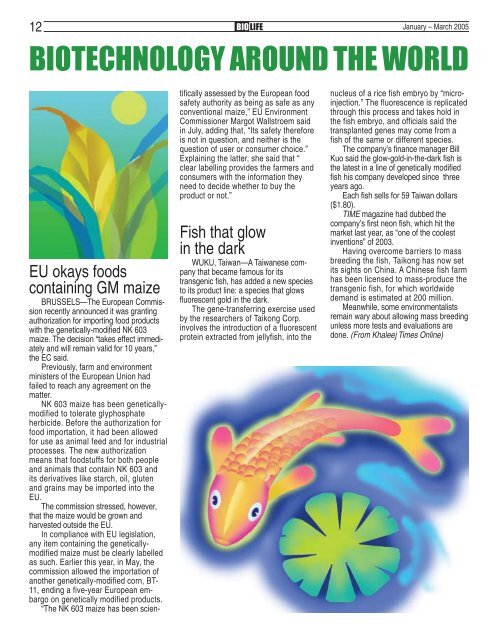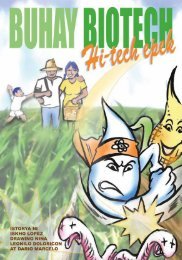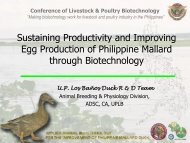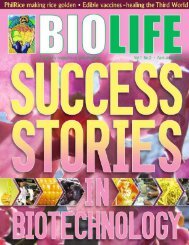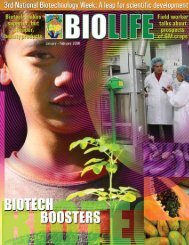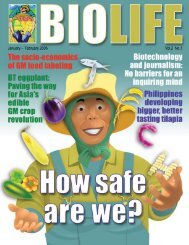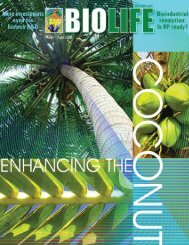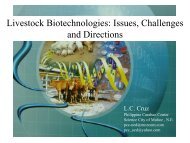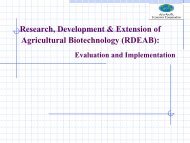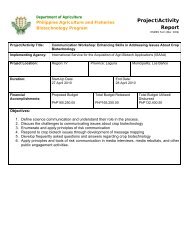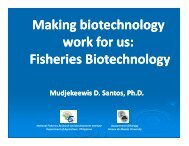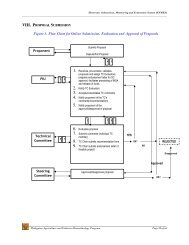Download PDF - SEARCA Biotechnology Information Center
Download PDF - SEARCA Biotechnology Information Center
Download PDF - SEARCA Biotechnology Information Center
Create successful ePaper yourself
Turn your PDF publications into a flip-book with our unique Google optimized e-Paper software.
12 BIO LIFE January – March 2005<br />
BIOTECHNOLOGY AROUND THE WORLD<br />
EU okays foods<br />
containing GM maize<br />
BRUSSELS—The European Commission<br />
recently announced it was granting<br />
authorization for importing food products<br />
with the genetically-modified NK 603<br />
maize. The decision “takes effect immediately<br />
and will remain valid for 10 years,”<br />
the EC said.<br />
Previously, farm and environment<br />
ministers of the European Union had<br />
failed to reach any agreement on the<br />
matter.<br />
NK 603 maize has been geneticallymodified<br />
to tolerate glyphosphate<br />
herbicide. Before the authorization for<br />
food importation, it had been allowed<br />
for use as animal feed and for industrial<br />
processes. The new authorization<br />
means that foodstuffs for both people<br />
and animals that contain NK 603 and<br />
its derivatives like starch, oil, gluten<br />
and grains may be imported into the<br />
EU.<br />
The commission stressed, however,<br />
that the maize would be grown and<br />
harvested outside the EU.<br />
In compliance with EU legislation,<br />
any item containing the geneticallymodified<br />
maize must be clearly labelled<br />
as such. Earlier this year, in May, the<br />
commission allowed the importation of<br />
another genetically-modified corn, BT-<br />
11, ending a five-year European embargo<br />
on genetically modified products.<br />
“The NK 603 maize has been scientifically<br />
assessed by the European food<br />
safety authority as being as safe as any<br />
conventional maize,” EU Environment<br />
Commissioner Margot Wallstroem said<br />
in July, adding that, “Its safety therefore<br />
is not in question, and neither is the<br />
question of user or consumer choice.”<br />
Explaining the latter, she said that “<br />
clear labelling provides the farmers and<br />
consumers with the information they<br />
need to decide whether to buy the<br />
product or not.”<br />
Fish that glow<br />
in the dark<br />
WUKU, Taiwan—A Taiwanese company<br />
that became famous for its<br />
transgenic fish, has added a new species<br />
to its product line: a species that glows<br />
fluorescent gold in the dark.<br />
The gene-transferring exercise used<br />
by the researchers of Taikong Corp.<br />
involves the introduction of a fluorescent<br />
protein extracted from jellyfish, into the<br />
nucleus of a rice fish embryo by “microinjection.”<br />
The fluorescence is replicated<br />
through this process and takes hold in<br />
the fish embryo, and officials said the<br />
transplanted genes may come from a<br />
fish of the same or different species.<br />
The company’s finance manager Bill<br />
Kuo said the glow-gold-in-the-dark fish is<br />
the latest in a line of genetically modified<br />
fish his company developed since three<br />
years ago.<br />
Each fish sells for 59 Taiwan dollars<br />
($1.80).<br />
TIME magazine had dubbed the<br />
company’s first neon fish, which hit the<br />
market last year, as “one of the coolest<br />
inventions” of 2003.<br />
Having overcome barriers to mass<br />
breeding the fish, Taikong has now set<br />
its sights on China. A Chinese fish farm<br />
has been licensed to mass-produce the<br />
transgenic fish, for which worldwide<br />
demand is estimated at 200 million.<br />
Meanwhile, some environmentalists<br />
remain wary about allowing mass breeding<br />
unless more tests and evaluations are<br />
done. (From Khaleej Times Online)


